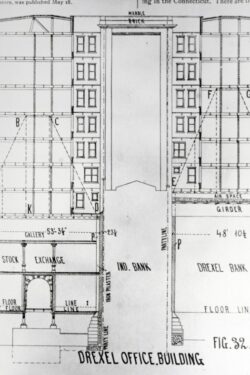Is it possible that Philadelphia is the birthplace of the skyscraper? George Thomas, preeminent scholar of the work of that city’s 19th-century genius architect Frank Furness, argues that the critical breakthroughs in modern construction systems came not from Chicago or New York, but from Philadelphia, where engineers and architects for the powerful Pennsylvania Railroad played a key role in translating their experience into high-rise office buildings. Mathews will focus in particular on the work of Furness’s principal competitor, the Wilson Brothers, led by engineer / architect Joseph Miller Wilson (1838-1902).
Joseph Wilson became the chief of the bridge department for the Pennsylvania Railroad and in 1875 took over the design of the principal buildings for the Centennial Exhibition. In 187?, he left the company and opened the Wilson Brothers practice which had clients across the western hemisphere. In 1879, their Broad Street Station in Philadelphia incorporated a frame of steel carrying masonry infill that, Matthews argues, predates similar systems in Chicago and suggests an alternative history to the modernist emphasis on the Midwestern origins of skeleton construction.
George E. Thomas
George E. Thomas is a principal in a Philadelphia consulting practice of CivicVisions, LP and is co-director of the Masters in Design Studies program in Critical Conservation in the Graduate School of Design at Harvard University. His most recent publication, Frank Furness: Architecture in the Age of the Great Machines (2018) won the Victorian Society in America’s book award for 2019.
View the DISCUSSION with Carol Willis's introduction and dialogue with George Thomas, Donald Friedman and Gerald Larson.
